This is an introduction to arpeggio-based soloing. It is part of our How To Get Better At Guitar Series. Using guitar arpeggio shapes to improvise solos can help to add interest to your solos.
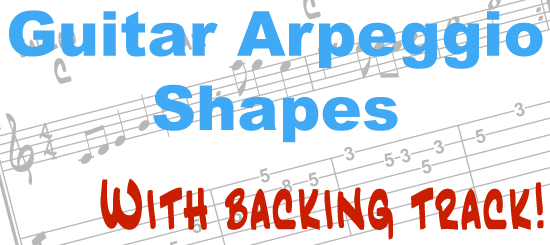
Learn arpeggio shapes then use them to play the example solos. Improvise your own solos over the backing tracks provided.
Using Guitar Arpeggio Shapes In Improvisation
Using arpeggios in improvisation is nothing new, but it is surprising the number of guitarists who play up and down scales without any thought to the chord changes.
You may have thought that the key to melodic playing is to use scales. However, breaking up scale-based lines with arpeggios can be the difference between something that sounds like a scale workout and a piece of music.
It is the leaps, pauses and phrasing that make a solo memorable.
Following The Chord Changes
When improvising with scales, it is easy to forget what chord you are playing over. You don't actually need to know – so long as the song doesn't change key!
Using arpeggios is different. You should try to play an arpeggio that corresponds to the chord you are playing over.
So, if you are playing over a C major chord, you should use a C major arpeggio. If the chord changes to an A minor, you should use an A minor arpeggio to improvise with.
You can then start to add additional notes, as we'll see below, but they will still be based on the underlying chord.
Basic Guitar Arpeggio Shapes
Below are two shapes that you can use to play arpeggios with. The first is a major shape, the second a minor shape.
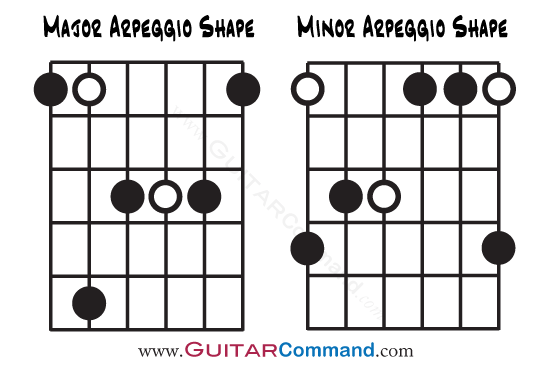
The white notes in the diagrams represent the root notes of the arpeggio.
For the examples below, play the major shape at the 3rd fret (C major arpeggio), and the minor shape at the 5th fret (A minor arpeggio).
[ad name="Google Adsense Lge Rec"]
Play the example solo over the chord progression. All of the notes are taken from either the C or Am arpeggio shapes shown above. Remember to use the major arpeggio shape to play over the major chords, and the minor arpeggio shape for the minor chord.
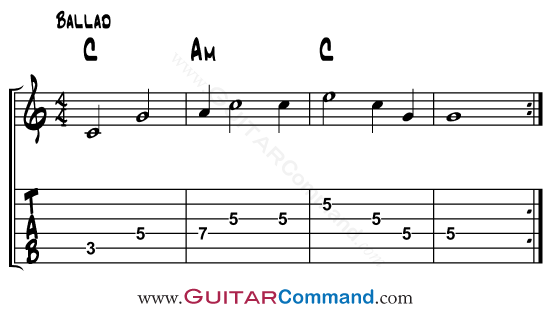
The melody is fairly basic, as you are limited to just three notes per chord. However, you can begin to see the possibilities when you incorporate scale playing as well.
Try improvising your own solo by combining the basic arpeggio shapes and a C major scale (see how to play major scales here). Use the backing track provided at the end of the article.
Seventh Arpeggio Shapes
Now we're going to add another note to our arpeggio shapes. For the major shape, a major 7th, and for the minor a minor 7th. The guitar arpeggio shapes are illustrated below.
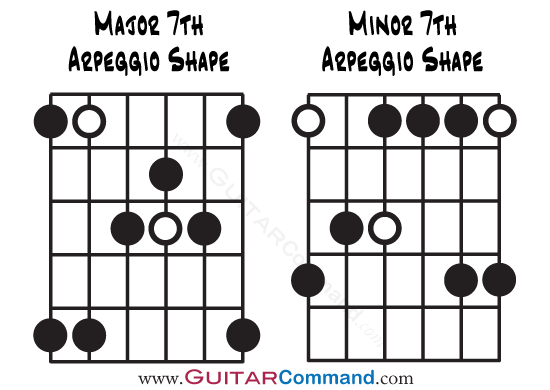
Play the example solo using the two arpeggio shapes. The seventh notes in each shape give you much more freedom.

Add 9 Arpeggio Shapes
The arpeggios shapes below contain a ninth note. Practice playing them, then try out the example solo.
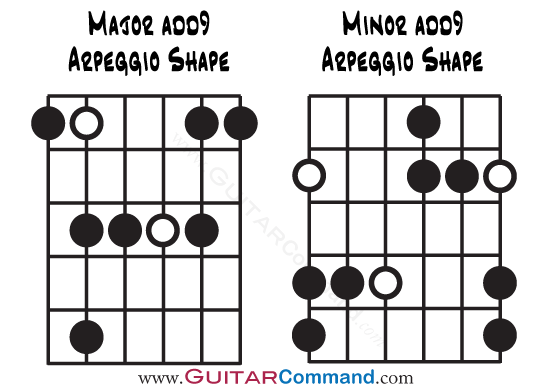
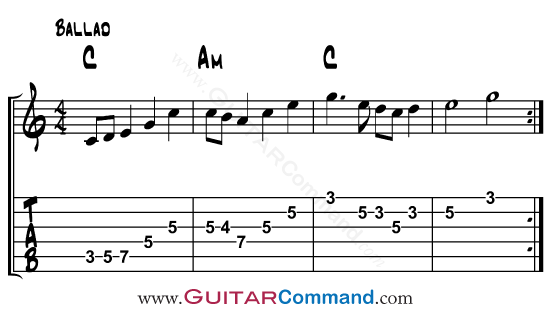
Now, combine the seventh arpeggio and add nine arpeggio shapes together with a C major chord. Improvise your own solo, using elements from each shape and scale.
Backing Track For Arpeggio Improvisation
Notes
Combined, the 7th and 9th arpeggios contain 5 out of the 7 notes in a major scale. However, using the arpeggio approach takes you away from the scale-based mindset.
[ad name="Google Adsense Lge Rec"]
Using arpeggios in this way has become known as 'vertical' playing, rather than scale-based 'horizontal' playing.
Try working out how to play some arpeggio shapes elsewhere on the guitar neck, and incorporating them in a solo.
If you enjoyed this lesson, please be sure to subscribe to the free Guitar Command email newsletter containing news, updates and lessons from the site. Fill in the form at the side of this page to join.
Read These Articles Next
How To Get Better At Guitar Series
Learn guitar scales all over the neck: Guitar Scale Exercises
Want to learn more scales and arpeggios for lead guitar? Check out our book, Guitar Chords, Scales & Arpeggios: The Complete Reference Book For Guitarists.

